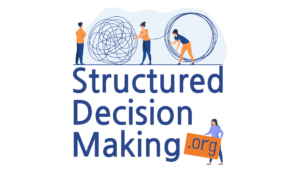Conceptual models of cause and effect
Having a shared understanding of cause and effect relationships is usually key to collaborative decision making. There are various structuring tools that are useful for helping groups build shared mental models of these key relationships. Such diagrams serve several important functions in the deliberations of a multi-stakeholder group:
- building a common understanding of “how things work”;
- facilitating communication among technical experts, decision makers and stakeholders;
- integrating knowledge from different sources in decision making (e.g., science, local or traditional knowledge, etc.)
- encouraging disciplined thinking about cause and effect relationships;
- being explicit about uncertainty, in particular, emphasizing the existence of competing hypotheses about what factors were most likely limiting fish, and facilitating informed debate about them;
- defining performance measures;
- determining and prioritizing information needs directly related to the performance measures;
- structuring quantitative models to estimate the consequences of options;
- documenting the basis for and improving the transparency of expert judgments.
Means-ends Networks/Diagram
Means-ends diagrams show at a high level the relationship between policy alternatives (means) at one end and fundamental objectives (ends) at the other. They are useful for developing a conceptual understanding of a system, for helping separate interests (objectives) from positions (means), and for identifying potential performance measures.

Influence Diagrams
An influence diagram is a decision structuring or modeling tool that graphically represents the relationship between decisions, uncertainties and outcomes, using nodes and arrows. It is similar to a mean-ends diagram, but with greater emphasis on documenting the full range of cause and effect relationships and clarifying uncertainties. They’re very flexible. They can be built at a conceptual level on-the-fly, to put some structure to complex discussions as they are taking place. Or they can be constructed more formally, as the product of a structured and in-depth workshop. In very formal applications, they are constructed according to formal rules, with different types of influences denoted with different shapes.
Influence diagrams differ from purely scientific conceptual models as the include the causal variables over which managers have some control, although other variables may also be represented. They can play an important role in defining performance measures and in determining modeling and information needs directly related to the performance measures. They facilitate communication among technical experts, decision makers and stakeholders about how a system works and what information is important in a decision.
This example shows management actions or means (orange), the fundamental objective (blue hexagon), various pathways and interim mechanisms by which the actions influence the fundamental objective (green) and some of the more important external influences (blue ovals).


